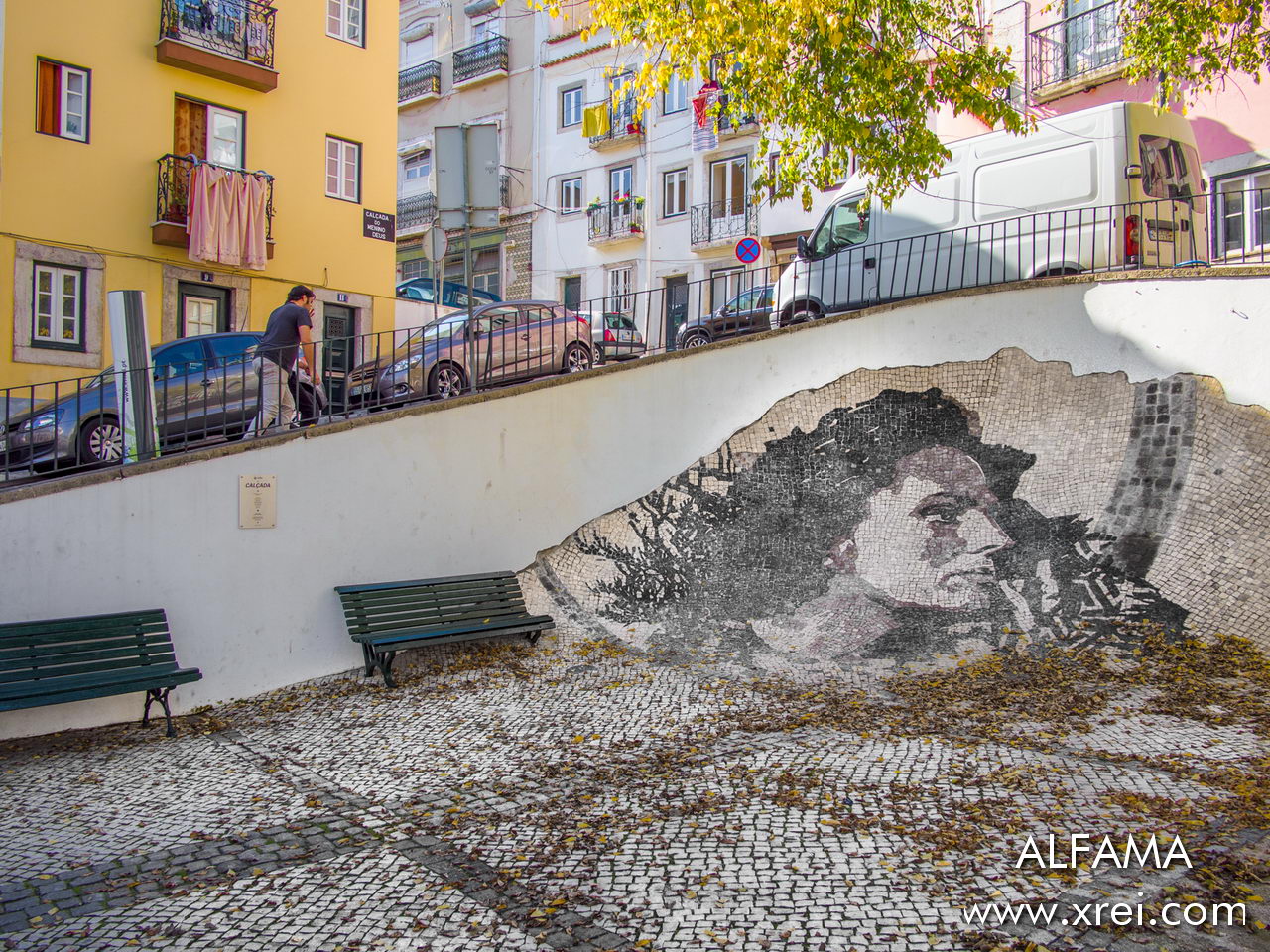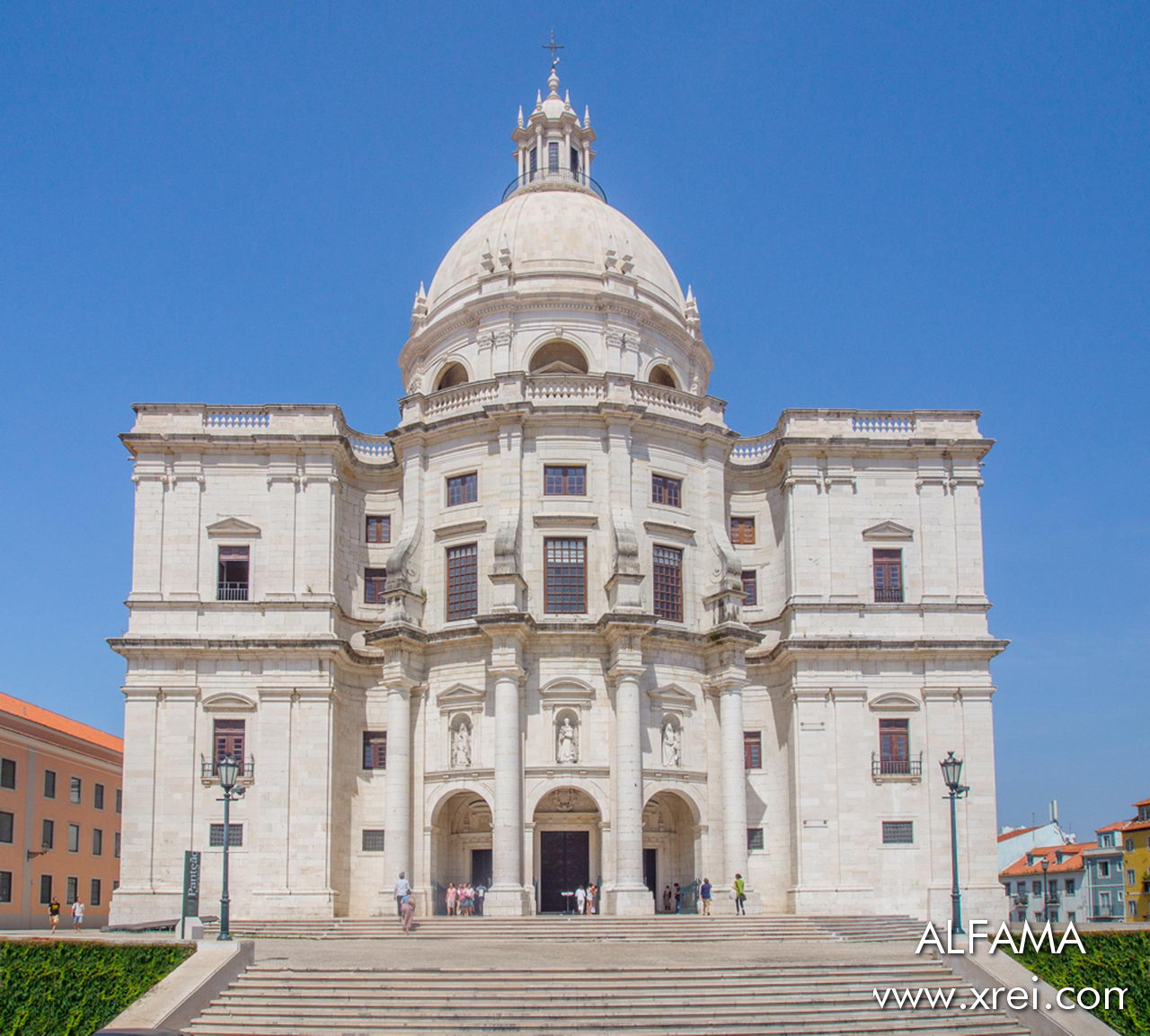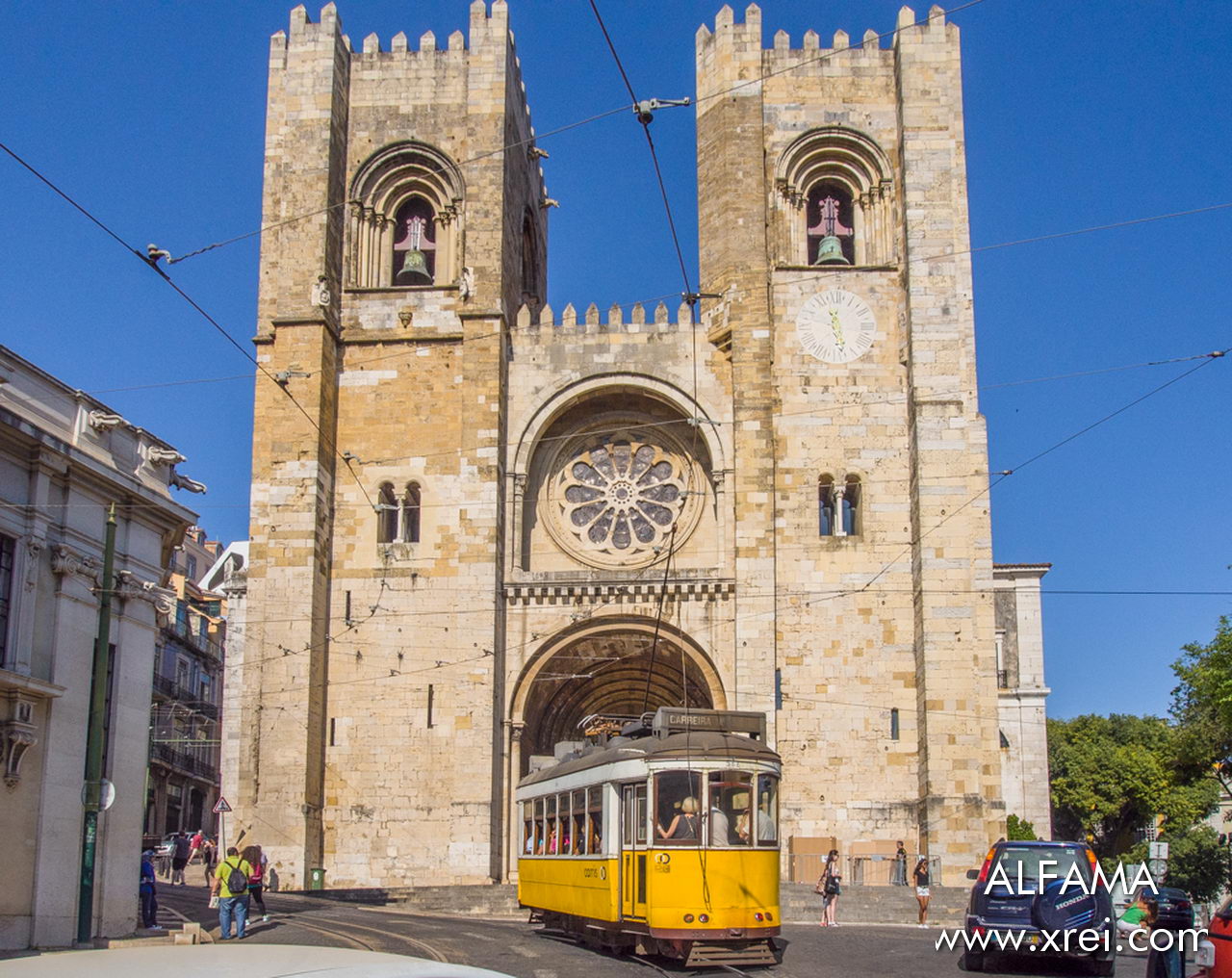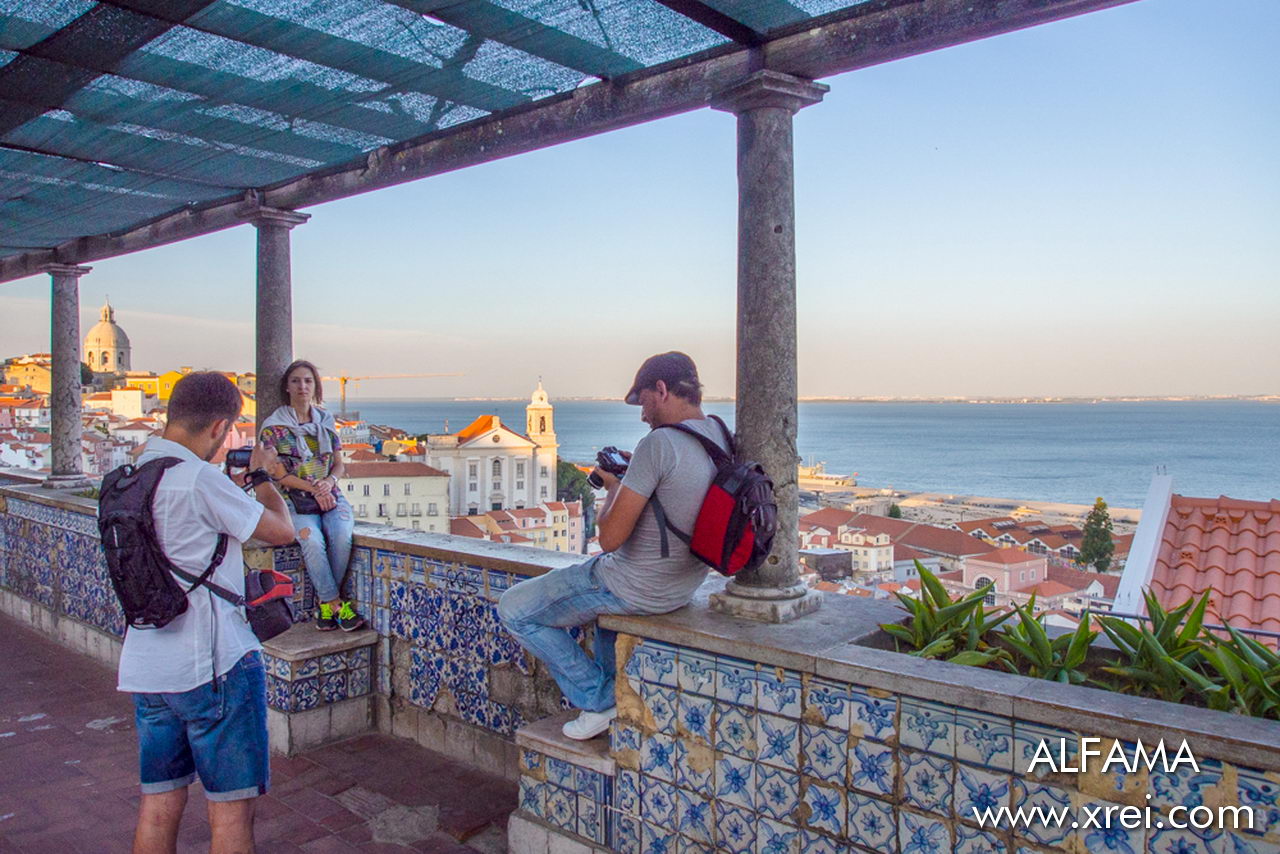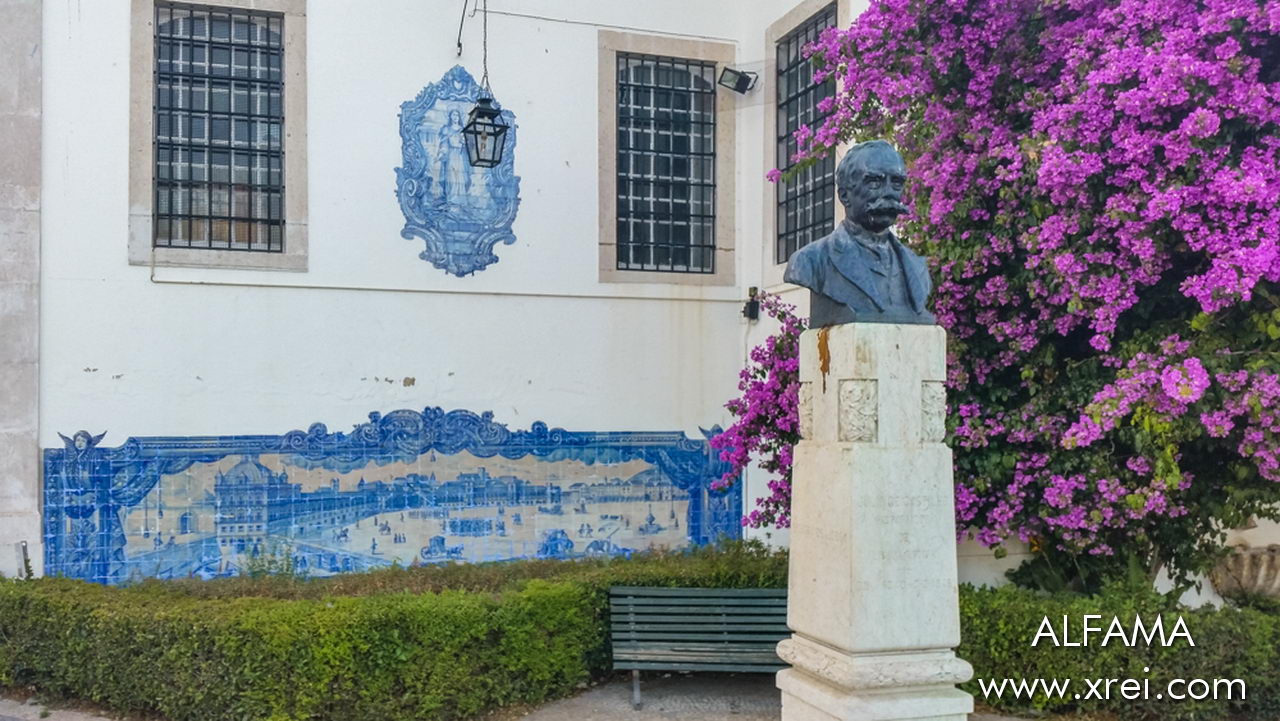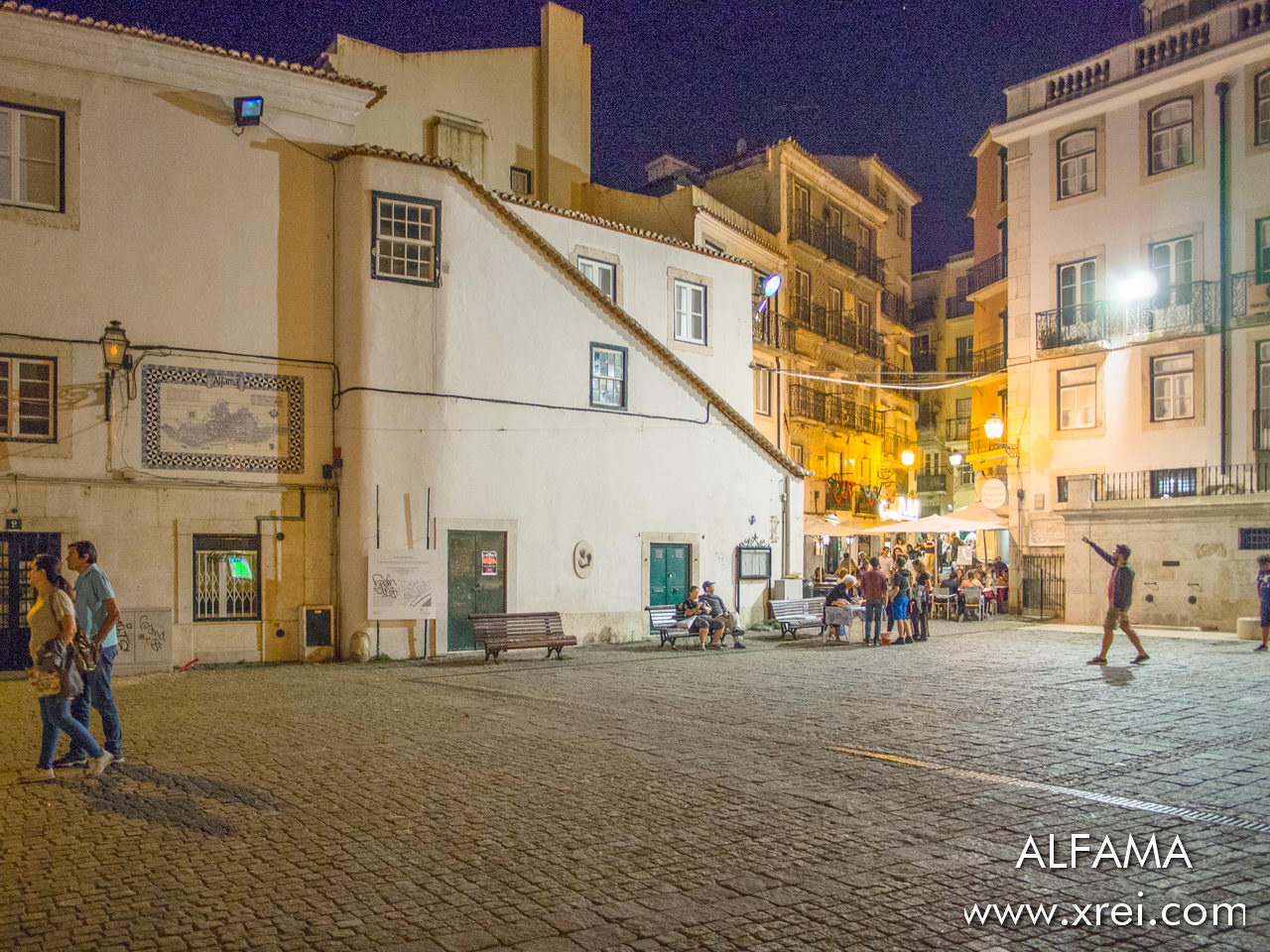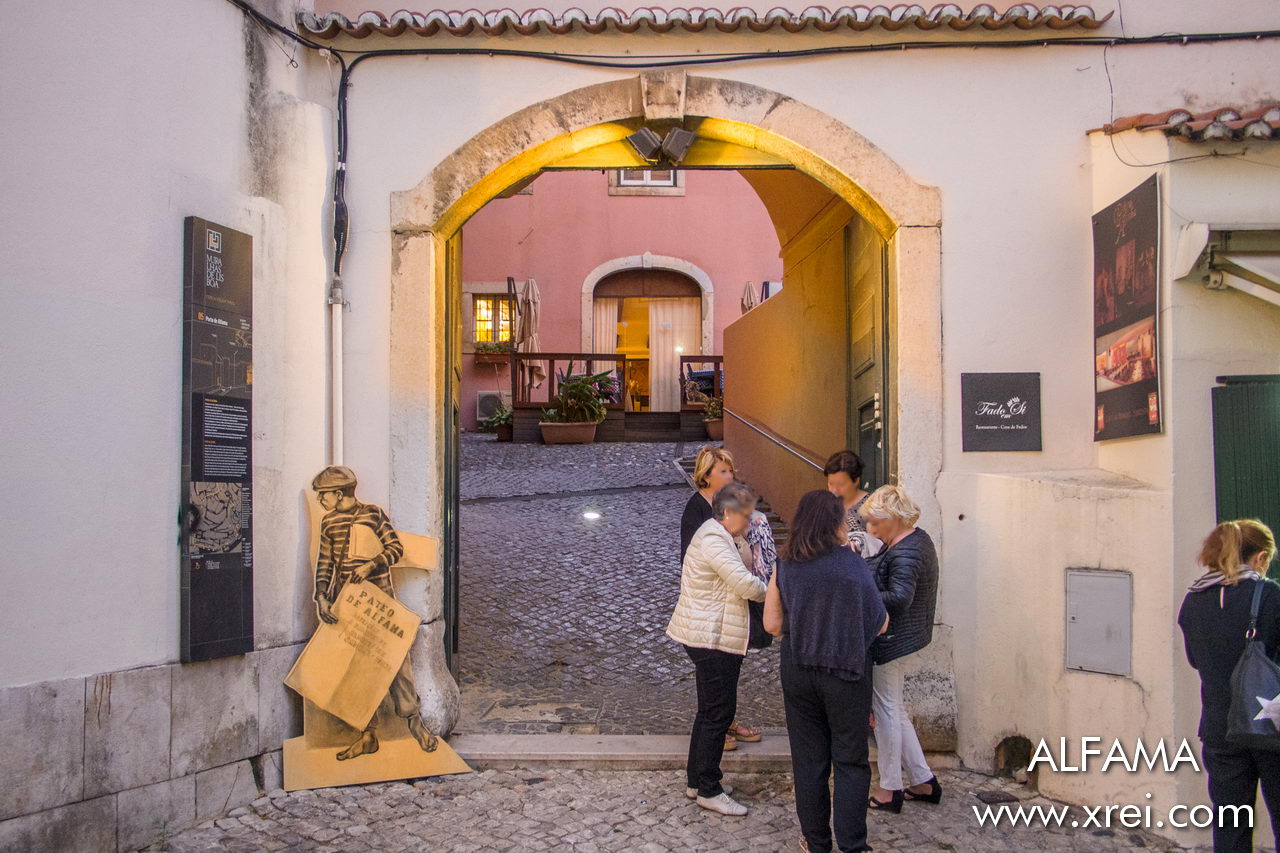In this article, you will get to know about...
Alfama
Alfama is the oldest neighborhood in Lisbon, and the second oldest in Europe. Alfama is a neighborhood where you can return to Lisbon from the Middle Ages and, at the same time, feel the modernity that accompanies the Portuguese capital. Located on a hill facing the river Tagus in Lisbon, from the Alfama district we can see the roofs of Lisbon arranged in an amphitheater, over the Tagus river and the south bank of Lisbon. Alfama is located in the historic center of Lisbon, bordering the neighborhood of Graça, Mouraria, Castelo and Baixa. Alfama is close to Lisbon’s luxury Avenida da Liberdade, cosmopolitan Chiado and bohemian Bairro Alto.
Alfama maintains the narrow streets, winding, labyrinthine with alleys and alleys. Here, you can see the clothes hanging out in the windows, people talking loudly from one window to the other as if they were in a small village, watching the doors of open houses during the day and listening to fado in the middle from street.
Alfama is one of the places where fado emerged, being highly sought after due to the numerous fado houses. It is tradition for fadistas to gather in the street to sing during the summer, providing a unique atmosphere for those who visit the neighborhood. Alfama is a calm, peaceful and safe place during the day, where groups of tourists pass by fado houses and restaurants, places where you can taste the much appreciated traditional Portuguese cuisine. One of the highlights of Alfama happens in June during the Festas da Cidade. The Alfama neighborhood is filled with thousands of people from all over the world who gather on the streets, where they live until dawn. Alfama is a safe place that provides excellent spaces for fun, rest, and tourism for visitors who come from all over the world to visit the neighborhood. At night, Alfama becomes a very popular place due to the large number of restaurants.
Fado became famous when the Conde de Vimioso began to promote it at the Portuguese Court with the creation of shows performed by Maria Severa Onofriana (1820-1846), recognized as the first fado singer. With the emergence of Amália Rodrigues, fado gained more notoriety and was recognized internationally, when Amália Rodrigues achieved an international career, the first time for a Portuguese artist. Some of today’s best known fadistas are from Alfama, namely Ricardo Ribeiro and Raquel Tavares or Artur Batalha. Fado has been classified as a World Heritage Site by UNESCO since 2011.
Explore Alfama
The best way to visit Alfama is walking through the streets, however the 28 tram is an excellent alternative to get here. The route of Tram 28 starts at Praça do Martim Moniz and ends in Campo de Ourique, passing through some of the main points of interest in the city, namely the Alfama district, Miradouro Nossa Senhora do Monte, Miradouro da Graça, Cathedral of Lisbon, Praça do Comércio, Rua Garrett, Praça Luís de Camões, Santa Catarina Viewpoint, Estrela Basilica, Estrela Garden, Campo de Ourique Market, Prazeres Cemetery or Santo Condestável Church in Campo de Ourique. The first trip starts at 6 am and ends after 11 pm, every day of the year. The tramway 28 has 50 trams available, each with a capacity for 20 seated passengers and 38 standing passengers. Line 28 was created in 1914 and is currently one of the symbols and one of the main tourist attractions in Lisbon.
Places to visit in Alfama (top 10)
- National Pantheon: The National Pantheon is part of the Church of Santa Engrácia, located in Campo de Santa Clara. It is a building dedicated to the memory of illustrious people, where their mortal remains are deposited. The current church began to be built in 1632 during the reign of Filipe III under the guidance of the architect Mateus Couto, having taken approximately 350 years to be built. The Church of Santa Engrácia performed several functions after the extinction of the Religious Orders in 1834, namely, barracks for the Second Battalion of the Lisbon National Guard, armament factory, and shoe production workshops. The Church of Santa Engrácia was classified as a National Pantheon in 1916, having undergone profound changes in the 1950s with the intervention of several architects, namely António Lino, Joaquim Areal e Silva, Raúl Lino and Luís Amoroso Lopes. The National Pantheon was inaugurated in 1966 on the fortieth anniversary of the Estado Novo, with the definitive construction of the reinforced concrete dome designed by the architect Edgar Cardoso. The illustrious Portuguese who are buried in the National Pantheon are:
- Manuel de Arriaga;
- Teófilo Braga;
- Sidonio Pais;
- Oscar Carmona;
- Almeida Garrett;
- Aquilino Ribeiro;
- War Junqueiro;
- John of God;
- Amália Rodrigues;
- Humberto Delgado;
- Sophia de Mello Breyner Andresen;
- Eusébio da Silva Ferreira.
The National Pantheon honors the following Portuguese personalities: - Luís Vaz de Camões;
- Pedro Álvares Cabral;
- Infante Dom Henrique;
- Vasco da Gama;
- Afonso de Albuquerque;
- Don Nuno Álvares Pereira.
Other monuments in Portugal recognized as National Pantheons are: - Monastery of Santa Cruz de Coimbra: where Dom Afonso Henriques and Dom Sancho I are buried; ;
- Alcobaça Monastery: where Dom Afonso II, Dom Afonso III and Dom Pedro I are buried;
- Battle Monastery: where Dom João I and Dona Filipa de Lencastre, Dom Duarte and Dona Leonor de Aragão, Dom Afonso V, Dom João II are buried; ;
- Jerónimos Monastery: where Dom Manuel I, Dom João III, Dom Sebastião and Cardinal Dom Henrique are buried;
- São Vicente de Fora Monastery: where Dom João IV to Dom Manuel II are buried, except for the tombs of Dom Pedro IV who is buried in the Cathedral of Petrópolis in Brazil, and of Dona Maria I who is buried in the Basilica da Estrela.
Other monuments where Kings and Queens of Portugal are buried, although they are not recognized as National Pantheons are: - Convent of Odivelas: Tomb of Dom Dinis;
- Lisbon Cathedral: Tomb of Dom Afonso IV;
- Museu do Carmo: Tomb of Dom Fernando I;
- Cathedral of Toledo in Spain: place where Dom Sancho II is buried.
The word “pantheon” comes from the Latin “pantheon” which means “temple consecrated to the Gods”. The first Church of Santa Engrácia in Portugal was built in 1570 at the behest of Dona Maria, the last daughter of King Dom Manuel I and devotee of Santa Engrácia.
- Sé Catedral de Lisboa: The Sé Catedral de Lisboa is the most important church in the city of Lisbon, located in Largo da Sé. The Sé Catedral de Lisboa was inaugurated in 1150 in the Romanesque style under supervision by Mestre Roberto, was officially designated the Church of Santa Maria Maior by order of Dom Afonso Henriques and the target of several interventions over the centuries, which included the construction of the cloister between 1281 and 1319 during the reign of Dom Dinis, the construction of the Chapel of São Bartolomeu in 1324, the Main Chapel during the Reign of Dom Afonso IV, the Cabeceira, painting of the cloister of the Cathedral by Mestre Manuel André in 1569, the Chapter Room and the Treasure Room during the Reign of Dom João V, the construction of the clock in 1743 and reconstruction of the Cathedral after the 1755 earthquake. The main highlights of Lisbon Cathedral are:
- Sacristy;
- Main Chapel;
- Tomb of Dom Afonso IV;
- Fountain where St. Anthony was baptized in 1195;
- Cloister;
- Archaeological excavations over three thousand years old in the Gothic Cloister;
- Nativity scene by Machado de Castro from 1766;
- Royal Treasure which includes pieces such as the Custody of Dom José I;
- Panoramic view of the Tagus River from the top of the tower.
- Monastery of São Vicente de Fora: The Monastery of São Vicente de Fora is one of the oldest monasteries in the city of Lisbon, having been built in gratitude for the Conquest of Lisbon in 1147. Construction of the Monastery of São Vicente de Fora began on November 21st, 1147, having been consecrated to Our Lady of Conceição da Enfermaria and São Vicente Mártir and handed over to Regular Order of St. Augustine. The current monastery was built during the Reign of Philip I (1527-1598) having as main architects Juan de Herrera (1530-1597), also responsible for the construction of the Monastery of San Lorenzo de El Escorial (1563-1584), Filippo Terzi ( 1520-1597), Baltazar Álvares (1560-1630), João Frederico Ludovice (1673-1752). The main points of interest of the São Vicente de Fora Monastery are:
- Pantheon of the Bragança Dynasty: The Pantheon of the Bragança Dynasty began to be planned by Dom João V, having only been completed in 1932. The 1932 project was conducted by the architect Raul Lino with a goal of designing a more dignified tomb for King Dom Carlos
- Facade with two towers: this construction was innovative, as the construction of two towers in a church was exclusive to Cathedral Churches. The construction of the two towers in the Church influenced the construction of other Christian temples throughout the country, namely the SÉ Nova in Coimbra (1598), the Igreja de São Lourenço (1690) ) in Porto or the Basílica da Estrela (1779) in Lisbon
- Cisterna: this is the only remaining structure of the monastery built by Dom Afonso Henriques. The cistern continues to function
- Largest collection of Baroque tiles in the world: The only structure that comes close is the Cloister of the Convent of São Francisco in Salvador da Bahia in Brazil
- Portaria of the Monastery of São Vicente de Fora: highlighting the representations in tile panels of episodes from the History of Portugal and the various Kings of Portugal who contributed to the construction of the Monastery and to the painting ceiling by Italian Vicenzo Baccarelli
- Cloister of the Monastery: the cloister of the Monastery of São Vicente was built in the 17th century and features 81 tile panels with approximately fifteen thousand tiles from the reign of Dom João V
- Santo António Chapel: Chapel where Teresa Teixeira, the mother of Santo António was buried;
- Sacristy: The sacristy was built by Dom João V and stands out for its opulence;
- Capela dos Meninos de Palhavã: The Chapel has this name because it was transferred from the Palácio da Palhavã in Lisbon, now the Spanish embassy. In the Chapel are buried the bastard sons of Dom João V
- Tile panels with the Fables of La Fontaine: The Fables of La Fontaine are represented in a total of 38 tile panels from the 18th century;
- Church Tower: The Church Tower is a privileged place to observe Lisbon, the Tagus River and the Serra da Arrábida;
- Organ: The organ of the Monastery of São Vicente de Fora was built in 1765 by João Fontanes de Maqueira. The organ has more than three thousand pipes spread over two keyboards and sixty registers. The organ of the Monastery of São Vicente de Fora is one of the largest organs in Portugal
Saint Vincent was a deacon in Zaragoza and one of the Hispanic martyrs and, according to legend, he was exposed to torture beyond the ordinary which led to his death on January 22, 304. São Vicente ended up in to be buried in a cemetery in Valencia and transferred to Cabo de São Vicente, in the Algarve, after the Muslim invasion of the Iberian Peninsula. Dom Afonso Henriques decided to send a fleet to Cabo de São Vicente to rescue the body and the relics, being transported on a ship to Lisbon and transformed into the great symbol of Christian unity against the Muslim enemy.
- Santa Luzia Viewpoint: The Santa Luzia Viewpoint is one of the most popular viewpoints in Lisbon due to the fantastic view over Alfama, the Tagus River and the Serra da Arrábida, located in Largo de Santa Luzia. The main highlights are the view over the Alfama district, the tile panels representing the Conquest of Lisbon in 1147, Praça do Comércio before the 1755 Earthquake and a bust in tribute to Lisbon Historian Norberto de Araújo. The Santa Luzia Viewpoint is well visited by tourists from all over the world, which contributes to a very pleasant environment in the city of Lisbon;
- Portas do Sol Viewpoint: The Portas do Sol Viewpoint is one of the most popular viewpoints in the city of Lisbon, located in Largo das Portas do Sol, also called Varanda do Tejo , near the São Jorge Castle. From the viewpoint you can see the National Pantheon, the São Vicente de Fora Monastery, the Alfama district, the Fado Museum, the São Miguel Church, the Santo Estêvão Church, the Tagus River and the Serra da Arrábida. The highlights of the viewpoint are:
- St. Vincent statue by Raul Xavier;
- Palácio Azurara where the Ricardo Espírito Santo Silva Foundation is located;
- Moorish fence of the 10th century
In Largo das Portas do Sol stands out: - Museum of Decorative Arts;
- Church of Santiago.
- Museum of Fado and Portuguese Guitar: The Museum of Fado is a museum where you can observe the historical evolution of Fado, watch shows of this Portuguese musical genre and learn to play the Portuguese guitar. The Fado Museum is located at Largo do Chafariz de Dentro, which connects with Rua de São Pedro, Rua dos Remédios and the Tagus River. This museum was inaugurated on September 25, 1998, featuring the following highlights:
- Work O Fado by José Malhoa from 1910;
- Triptych The Sailor by Constantino Fernandes, 1913;
- The Most Portuguese of João Vieira’s Oil Paintings from 2005;
- Display of musical instruments and costumes;
- Documentation Center where you can study Fado;
- Museum School where you can learn to sing Fado and play Portuguese guitar.
- Santo Estêvão Viewpoint: The Santo Estêvão Viewpoint is one of the lesser known viewpoints in the Alfama district, located in the courtyard in front of the Santo Estêvão Church, it is a quiet place away from the hustle and bustle from other well-known viewpoints in the city, which allow you to contemplate the Alfama district, the Serra da Arrábida and the Tagus River.
- Church of Nossa Senhora da Conceição-a-Velha: The Church of Nossa Senhora da Conceição-a-Velha is the church that establishes the end of Baixa Pombalina and the beginning of Alfama. The first church was built in 1496 with the name of Igreja da Conceição dos Frades, replacing the Synagogue that existed there during the 15th century, having been destroyed by the earthquake of 1755. The current church was rebuilt after the earthquake with a project by Francisco António Ferreira. The main points of interest of the Church of Nossa Senhora da Conceição-a-Velha are:
- Main facade: it is believed that this is what remains of the initial church, prior to the earthquake of 1755. The facade is a portico built in Manueline style where the presence of Nossa Senhora da Misericórdia stands out. and the Virgin Mary with a cloak to protect the entire Portuguese Society;
- Church Nave: The ceiling painted in stucco representing the Triumph of Our Lady of Conception by Félix da Rocha;
- Statues representing São Pedro and São Paulo by José de Almeida;
- Chapel-Mor: The current Chapel-Mor was initially a side chapel built by Simoa Godinha (1530-1594), a rich black noblewoman from São Tomé and Príncipe, a large sugar producer . The highlight of the Capela-Mor goes to the statue of Nossa Senhora da Conceição-a-Velha carved between 1730 and 1740 by José de Almeida; ;
- Image of Our Lady of Belém: The image of Our Lady of Belém was commissioned by Infante Dom Henrique (1394-1460) for a small church that belonged to the Order of Christ and was destroyed for that the Jerónimos Monastery could be built. The image is important because it was to her that, according to oral tradition, Vasco da Gama prayed before leaving for India in 1498;
- Tube Organ: This small organ came from Palácio das Necessidades in Lisbon.
- Roman Theater: The Roman Theater is an archaeological site dating back to the 1st century AD, with an estimated capacity for 4 thousand spectators. It is one of the five poles of the Lisbon Museum, together with the Pimenta Palace, the Santo António Museum, the Casa dos Bicos and the Torreão Poente at Praça do Comércio. The Roman Theater is located between Rua de São Mamede and Rua da Saudade, which connects Largo do Caldas and Rua da Madalena. The ruins of the Roman Theater were discovered in 1798, having been recreated for the first time by the Italian architect Francisco Xavier Fabri. The Teatro Romano was the target of several archaeological interventions over the years, namely between 1964 and 1967 under the supervision of Fernando de Almeida and by Irisalva Moita, between 1989 and 1993 under the supervision of the Lisbon Museum and Lisbon City Council and inaugurated in 2001. The museum has been integrated into two buildings, an 18th century Palace and an old 19th century factory.
- Casa dos Bicos: Casa dos Bicos is one of the hubs of the Lisbon Museum and site of the José Saramago Foundation, Nobel Prize for Literature, and is located in Campo das Cebolas. The Casa dos Bicos was built by Brás de Albuquerque, son of Afonso de Albuquerque, Viceroy of India between 1521 and 1523 under the guidance of Francisco de Arruda. The main façade of the palace was inspired by the Palace of Diamonds of Ferrara in Italy, and ended up being built in the shape of stone beaks instead of diamonds, hence the current designation. Casa dos Bicos was partially destroyed by the 1755 Earthquake and later rehabilitated, in 1981 under the guidance of the architects Manuel Vicente and Daniel Santa Rita, with the aim of integrating the European Exhibition of Art, Science and Culture and to inaugurate the nucleus The Portuguese Discoveries and the Renaissance Europe. The Casa dos Bicos building performed several functions, including a cod warehouse, headquarters of the National Commission for the Commemoration of the Portuguese Discoveries between 1987 and 2002, Council of Culture of the Lisbon City Council between 2003 and 2008 and José Saramago Foundation from 2008 to the present. The highlights of Casa dos Bicos are as follows:
- Ruins of Roman Lisbon: Here we highlight the discovery of fish spice factories from the 1st century AD, part of the Roman wall of Lisbon, a semicircular tower from the 3rd century
- José Saramago Foundation: The Jose Saramago Foundation is located on the two upper floors of Casa dos Bicos, where you can observe and study the writer’s work
- Medieval Wall: Part of the medieval wall was discovered
- Cetacias: Cetacias are rectangular-shaped tanks that were used in factories during the Period of Roman Occupation
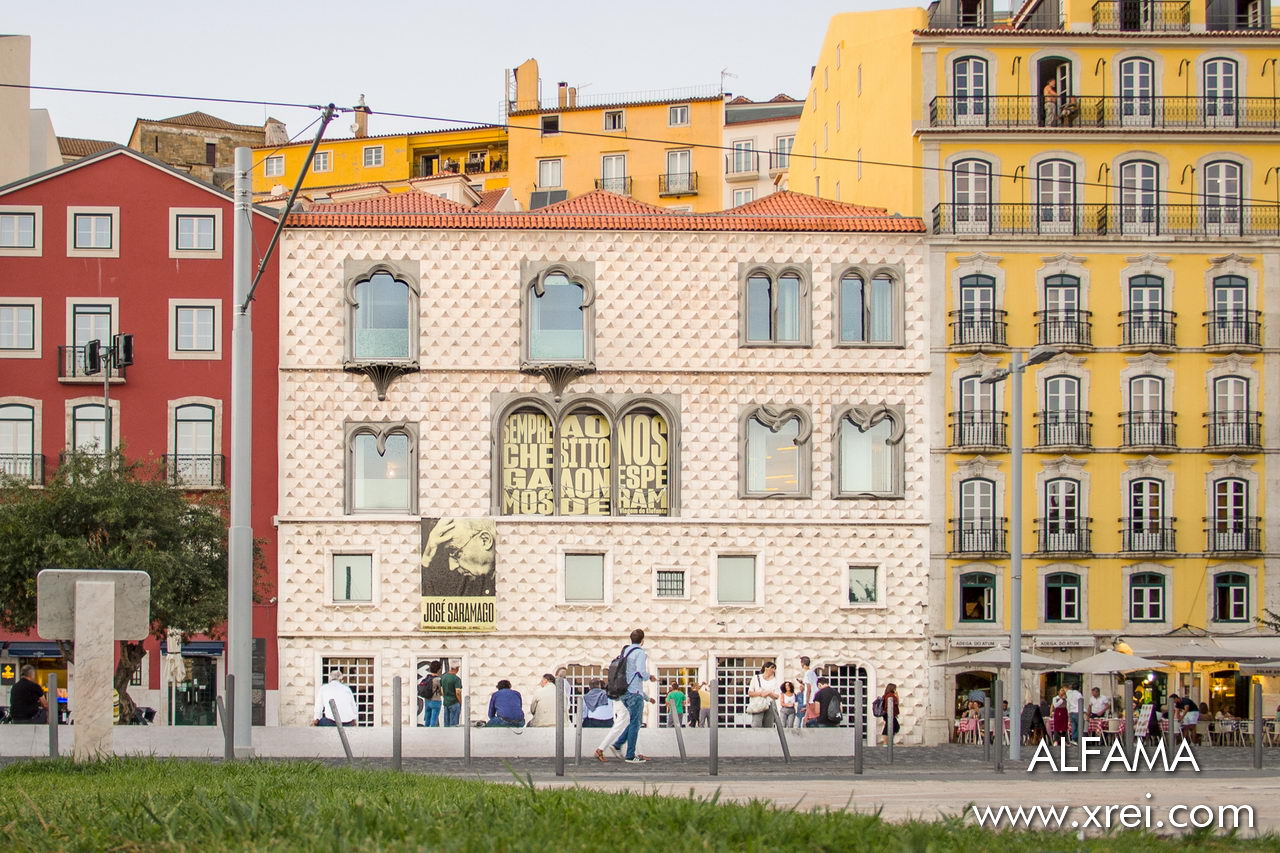
Casa dos Bicos, Lisbon museum hub and site of the José Saramago Foundation – Nobel Prize for Literature
Other places to explore in Alfama
- Igreja de Santo António: The Church of Santo António is a symbolic place of the city of Lisbon as it was built in the place where Santo António was born in 1190 in the current Largo of Santo António da Sé. The construction of the church was carried out from 1495 during the reign of Dom João II and completed during the reign of Dom Manuel I. The current church was completely rebuilt between 1767 and 1812 under the guidance of the architect Mateus Vicente de Oliveira (1706-1786). The main points of interest are:
- Statue of Saint Anthony inaugurated by Pope John Paul II during his visit to Portugal in 1982 and by Soares Branco;
- Neoclassical style facade;
- Tombstone with inscription of the brief of Pope Pius VI granting plenary indulgence to those visiting the Casa de Santo António;
- Coat of arms of Portugal and of the Bulhões family, name of the family of Santo António painted on the narthex of the church;
- Organ built in 1872;
- Room where St. Anthony was born.
- Igreja de São Miguel: The Church of São Miguel is the most important church in the Alfama district, being located in Largo de São Miguel. The Church of São Miguel was inaugurated in 1295, and the current version was built between 1673 and 1720 under the guidance of the architect João Nunes Tinoco and constitutes one of the largest groups of gilded wood carving in the city of Lisbon. The highlights of the Igreja de São Miguel are:
- St. Michael statue on the main facade;
- Wooden ceiling painted in fifteen watercolors representing angels;
- Santo António Chapel entirely covered with gilded woodcarving;
- Sixteen paintings framed in gilt with representations of the New Testament by Bento Coelho da Silveira (1617-1706);
- Moor Chapel in gilded woodcarving with an image of Saint Michael in the center and beside a statue of Saint Joseph and another of Our Lady of Boa Viagem
- Military Museum of Lisbon: The Military Museum of Lisbon is the oldest museum in Lisbon, having been inaugurated on December 10, 1851 as the Artillery Museum, located in Largo do Museu de Artilharia in Alfama, close to the Santa Apolónia Train Station and the Cruise Terminal. The Lisbon Military Museum aims to disclose the military history of Portugal, having a set of more than 26 thousand pieces on display. The Lisbon Military Museum building was damaged twice, namely by an explosion and the 1755 earthquake. The Lisbon Military Museum features the following highlights:
- Main facade with a female sculpture that symbolizes the Motherland;
- Central Courtyard with cannons and twenty-six panels of tiles that tell the history of Portugal, from the 12th century Reconquest to the First World War (1914-1918);
- Collection of artillery pieces in bronze, one of the largest artillery collections in the world;
- Vehicle used to transport the columns that are part of the Arco da Rua Augusta;
- Vasco da Gama Room: with paintings by Columbano Bordalo Pinheiro such as “O Velho do Restelo”, which portrays the Discovery of the Maritime Way to India, “The Mural” by Carlos Reis, the roof of the building by Luigi Manini;
- Sala América: highlight for the ceiling painted by Columbano Bordalo Pinheiro;
- Space dedicated to João Maria Ferreira do Amaral, commander of Infantry Battalion 15, the most decorated unit of the Portuguese Infantry due to the deeds at the Battle of La Lys on April 9, 1918. João Maria Ferreira do Amaral wrote after the First World War the book “The Lie of Flanders” and “The Fear” where he criticized the politics of the time.
- Great War Rooms: in this room we highlight the paintings by the painter Sousa Lopes with representations of the First World War and the Monument to the Unknown Soldier.
- Painting in homage to Amália Rodrigues – The Painting in Homage to Amália Rodrigues is dedicated to the most renowned Portuguese fado singer. The painting is located between Rua de São Tomé and Calçada do Menino de Deus in Alfama. The painting was inaugurated on July 2, 2015, by the urban art artist Vhils and the Lisbon City Council’s School of Calceteiros.
- Aljube Museum: Resistance and Freedom: The Aljube Museum: Resistance and Freedom is a museum dedicated to the dissemination of the struggle against the dictatorial regime that ruled Portugal between 1926 and 1974, located in the Pátio do Aljube, between the Cathedral of Lisbon and the Miradouro de Santa Luzia in Alfama. The museum is integrated into the Aljube building, a word with Arabic origins “al-jubb” which means well without water, dungeon or prison. The building has been a prison since its foundation in the Roman Period, namely for clerics, women in the 19th century and political resistance between 1928 and 1965. The museum is structured as follows:
- Less 1st Floor: Archaeological remains from the Roman and Islamic Period;
- Zero Floor: Former prison main door, current museum entrance;
- Floor 1: Location where part of the Permanent Exhibition with the following nuclei is located: Rise and Fall of Fascisms, Portugal 1890-1976, Undisputed Certainties, Underground Press, Underground and Police and Political Courts;
- Floor 2: Place where part of the Permanent Exhibition is located with the following nuclei: Resisting, Prison Circuit, Identification, Interrogation and Torture, Prisons and Concentration Camps, Resisting in Jails and Isolation in the ” curros”;
- Floor 3: Location where part of the Permanent Exhibition with the following nuclei is located: Colonialism and anti-colonial struggle, Those who stayed by the way, Freedom April 25, 1974, Memory and Citizenship, Centro de Documentation;
- Floor 4: Auditorium and Cafeteria.
- Igreja de Santo Estêvão: The Church of Santo Estêvão is a church that integrates one of the oldest parishes in Lisbon, created in 1183 and is located in Largo de Santo Estêvão. The first church was built between 1316 and 1543, having been heavily affected by the earthquake of 1755. The current church was inaugurated in 1775. The Church of Santo Estêvão has the following highlights:
- Chapel of Our Lady of Monte do Carmo with wooden statuette;
- Chapel of Our Lady of Conception with a marble medallion representing Sant’Ana;
- Mor Chapel with representations of the Evangelists, pink marble decoration from Serra da Arrábida;
- Christ crucified flanked by two seraphim by José de Almeida and Jerónimo da Costa;
- Image of Saint Stephen by Nicolau Pinto;
- 17th century tile panels with biblical scenes.
- Chafariz d’El-Rei: The Fountain d’El-Rei is one of the oldest fountains in the city of Lisbon, dating back to the Islamic period. The fountain is located at Travessa do Chafariz d’El-Rei in Alfama. This fountain was built in the 13th century during the reign of Dom Dinis (1281-1325) and was successively altered until it reached its current appearance dating from the 19th century. The Chafariz d’El-Rei is part of the Marquês de Angeja Palace and features the following highlights:
- Top floor with a terrace
- Bottom floor with taps
- Panels with two caravels and the arms of Lisbon.
- Chafariz de Dentro: The Chafariz de Dentro is one of the water supply points for the population of Alfama and is located in Largo do Chafariz de Dentro. The fountain was inaugurated in the 13th century and got its name due to being inside the Fernandina Fence built during the reign of Dom Fernando I (1345-1383), known as Chafariz dos Cavalos due to the existence of Bronze horses that decorated the façade, which were probably stolen by Spanish troops during the siege of Lisbon in 1384. The main highlight of the Chafariz de Dentro is the façade built in the Baroque and Romantic style, being the version current from 1872.
- Museum-School of Decorative Arts: The Museum-School of Decorative Arts is a museum-school that aims to promote the various decorative styles of Portuguese manor houses between the 17th and 19th centuries. Azurara Palace in Largo das Portas do Sol. The Azurara Palace performed various functions throughout the 20th century, namely the Army General Staff between 1902 and 1907, religious college of Dona Júlia Brito e Cunha between 1907 and 1912, hospice related to the hydrophobia (fear of water or liquids) between 1913 and 1933. The Palácio Azurara was purchased by Ricardo Espírito Santo Silva in 1947, who restored it with a project by the architect Raul Lino (1879-1974). The main highlights of the Museum-School of Decorative Arts are:
- Escadaria Nobre: The Escadaria Nobre presents as main points of interest the tile panels designed by Bartolomeu Antunes (1688-1753), a mirror with a gilded carving frame, two Flemish tapestries from the century XVI or XVII and two porcelain vases from the Qing dynasty of China;
- Salão Nobre: The Salão Nobre presents themes related to the exoticism of the Orient and the Portuguese expansion, namely a tapestry with representations of animals and characters from the Orient, an Indo-Portuguese office built in present-day Mongolia and the 18th century Arraiolos rug;
- Portuguese Chair Nucleus: in the Portuguese Chair Nucleus there are more than 300 chairs and 30 canapés / sofas dating from the 17th to the 19th century from the private collection of Ricardo do Espírito Santo Silva;
- Sala das Vitrinas: The Sala das Vitrinas is so named due to the presence of several showcases that are part of the Museum’s faience collection dating from the 18th to the 20th century. The Faiences come from all over the country, namely from the former Real Fábrica do Rato de Lisboa, from Viana do Castelo, Miragaia or Massarelos;
- Dom José I (1750-1777) and Dona Maria I (1777-1816) Rooms: in the Dom José I and Dona Maria Rooms the main highlights are the Rococo style furniture and a painting representing the “Virgem do Leite” by Gregório Lopes;
- Sala Cadaval: in the Sala Cadaval special mention should be made of the 16th century triptych representing Saint Bartholomew, Lamentation on the Dead Christ and Saint Francis by Gregório Lopes (1490-1550);
- Sala dos Nativity Scenes: in the Room of Nativity Scenes, the Nativity scene with terracotta figures by Silvestre Faria Lobo is highlighted;
- Dom João V Room: The Dom João V Room features a portrait of Dom João V painted by Pierre Antoine Quillard (1701-1753).
- Church of the Child of God: The Church of the Child of God is known for the luxury and luxury of the Baroque style, having served as an inspiration for the construction of other churches in the city, located in Calçada do Menino God’s. The current church was built between 1711 and 1730 under the guidance of several architects, namely João Antunes (1643-1712) and João Frederico Ludovice (1673-1752). The current Church was built by Dom João V (1689-1750) with the aim of housing an image of the Child of God who would perform miracles offered by the Abbess of Madre de Deus Cecília de Jesus.(1694- 1766). The highlights of the church are the Golden carved altarpieces by painters such as Vieira Lusitano, André Rubira and André Gonçalves.
- 16th century residential house: The 16th century residential house is one of the few residential houses that exist in Lisbon before the 1755 earthquake. This house is located in Rua dos Cegos, close to Rua de São Tomé and features as its main highlight a tile panel from the 1940s.
- Church of Santa Luzia and São Brás: The Church of Santa Luzia and São Brás is a church that belongs to the Order of Malta, being located in Largo de Santa Luzia. Santa Luzia is the patron saint of vision and São Brás the patron of medicine for the Order of Malta. The Church of Santa Luzia and São Brás was built during the reign of Dom Afonso Henriques and donated to the Order of Malta in gratitude for the help given in the conquest of the city of Lisbon from the Moors in 1147, and later transformed into a fortress-church. The current church was rebuilt after the 1755 earthquake under the guidance of architect Mateus Vicente Oliveira. The main points of interest are:
- Tile panel representing Lisbon before the 1755 Earthquake;
- Tile panel representing the Conquest of Lisbon from the Moors in 1147;
- Ten tombs with Latin inscriptions;
- Statue of Dom Nuno Álvares Pereira;
- Statue of Queen St. Elizabeth.
Historical classified establishments
- Estrela da Sé Restaurant: The Estrela da Sé Restaurant is named in honor of the owner’s birthplace, Santiago de Compostela, which means field of stars. Agapito Fernandes was the founder of the restaurant in 1857. The gastronomic specialties of the Restaurant Estrela da Sé are black pudding, roasted chorizo, fried alheira fava beans, Bife à Estrela or Iscas à Portuguesa
The main streets and squares of Alfama 26 words
- Rua dos Remédios: Rua dos Remédios is the most important street in Alfama, being the main place of commerce and restaurants in the Lisbon neighborhood. Rua dos Remédios is so named due to the presence of the Hermida de Nossa Senhora dos Remédios, having been designated as Rua das Portas do Sol until 1859. Rua dos Remédios presents as main attraction the Chapel of Our Lady of Remedies;
- Rua de São Pedro: Rua de São Pedro is also known as Rua Direita de São Pedro, where you can find several restaurants, stores and fado houses. This street connects Largo do Chafariz de Dentro and Rua de São Miguel. Rua de São Pedro was mentioned for the first time in 1191 by the Bishop of Lisbon Dom Soeiro Annes, responsible for the Church of São Pedro de Alfama, transferred in 1770 to the Parish of São Pedro de Alcântara with the name of Church of São Pedro de Alcântara;
- Largo de São Miguel: Largo de São Miguel is the heart of the Alfama district and connects Rua de São Miguel to Travessa do Terreiro do Trigo. The Largo de São Miguel is so named due to the existence of the Church of São Miguel.
- Rua de São Miguel: Rua de São Miguel is the right medieval street in Alfama that connects Largo de São Miguel and Rua dos Remédios. Rua de São Miguel was built between 1150 and 1180;
- Largo do Chafariz de Dentro: Largo do Chafariz de Dentro is considered the rossio de Alfama, a large space where you can enjoy, walk and visit the fair of handicrafts that take place every Thursday of the year, except for the month of July due to the Festas de Santo António de Lisboa. Largo do Chafariz de Dentro connects Rua do Terreiro do Trigo, Rua do Jardim do Tabaco, Rua dos Remédios and Rua de São Pedro. This square is so named due to the fact that the fountain is located within the Fernandina Fence built between 1373 and 1375 by King Dom Fernando I. The main highlights of the Largo do Chafariz de Dentro are the Chafariz de Dentro and the Fado Museum.
The Fado Houses
- Clube de Fado: located on Rua de São João da Praça, near the Cathedral of Lisbon, the Clube de Fado stands out for its cozy and romantic atmosphere. Clube do Fado is part of a building with more than three hundred years and that stands out for the interior, namely the arches, the very thick walls, the ceiling or the Poço Moiro. There are several artists working in the Clube de Fado, namely Mário Pacheco, Cuca Roseta and Carlos Leitão;
- Casa de Linhares: located halfway between the Cathedral of Lisbon and the Tagus River, the Casa de Linhares is officially called Bacalhau do Molho. The Casa de Linhares was the place where the Counts of Linhares lived and stands out for its vaulted ceilings, the large fireplace that makes the space welcoming, the cobbled floor, the rustic wooden tables and the red illuminated sofas against the walls . Casa de Linhares features a cast of quality artists, namely Jorge Fernando and Fábia Rebordão;
- Taverna del Rey: located in Largo do Chafariz de Dentro, the Taverna del Rey is one of the most famous fado houses in Alfama. The Taverna del Rey stands out for its wooden ceiling decoration simulating the caravels used in the Portuguese Discoveries and the Portuguese pavement floor with themes related to fado. In the Taverna del Rey famous fado singers, namely Tony de Matos and Fernando Maurício, performed throughout the times.
- Mesa de Frades: located on Rua dos Remédios, the space of the Mesa de Frades was once a chapel, a grocery store and a tavern. The decoration with blue tiles, the cozy atmosphere and the quality of the food make it one of the most popular fado houses in Lisbon. Renowned fado singers sing here, namely Ricardo Ribeiro and Pedro Moutinho;
- Parreirinha de Alfama: located near Rua dos Remédios, Parreirinha de Alfama was founded by Argentina Santos, a legend of the fate. Artists such as Amália Rodrigues, Alfredo Marceneiro or Maria da Fé performed in A Parreirinha de Alfama. The restaurant stands out for its decoration with motifs related to fado and Portuguese cuisine;
- Tasca do Jaime d’Alfama ;
- Mister Fado;
- Fadistas Winery;
- The Baiúca ;
- Dragon of Alfama ;
- A Travessa do Fado – Bij Alfama;
- Alfama Corner;
- Páteo de Alfama;
- Pastel do Fado;
- Lisbon Guitars;
- Fado in Morgadinha;
- Heart of Alfama;
- São Miguel de Alfama;
- Boteco da Fá;
- Tasca Bela;
- Tasca do Chico;
- Duets of the Cathedral.
Alfama Parish Council is Santa Maria Maior Parish Council
Teaching Establishments in Alfama
- Almeida Garrett Higher School of Education;
- University Institute of Psychological, Social and Life Sciences.
Tourist Resorts in Alfama
- Alfama Patio
- Hotel Convento do Salvador
- Memmo Alfama
- Chafariz d’el Rei Palace
- Santiago de Alfama: Boutique Hotel
Fairs, Parties and Pilgrimages
- Feira da Ladra: held weekly on Tuesdays and Saturdays in the morning near the National Pantheon;
- Santos Populares de Lisboa: held annually during the month of June, with the high point on the 12th;
- CaixaAlfama: held annually in September.
Transport and Access in Alfama
Alfama has the following public transport available:
- Lisbon Metropolitano: along the Avenue there are three stations:
Santa Apolónia Station (Blue Line) - Train: Santa Apolónia Station
- Car Parks: Portas do Sol Viewpoint
Alphama’s History
Alfama was one of the city’s Jewish neighborhoods. The name Alfama comes from the Arabic word “Al-Hamma”, which means hot baths or spas. Until the beginning of the 20th century Alfama was known for its sources of treatment of groundwater diseases, with healing properties and temperatures reaching 40ºC. Muslims divided Alfama into two zones:
- Alfama do Alto, where the aristocracy lived, and;
- Alfama do Mar, the place closest to the river, where the people lived.
Alfama was the place where Muslims first lived, and later Jews after the Christian Reconquest. From the Middle Ages onwards, Alfama entered a decline that lasted until the second half of the 20th century. Alfama was a neighborhood with high crime until the 1990s, when it started to recover. Currently, it is one of the most sought after neighborhoods to live and visit due to the security and rehabilitation that has been carried out over the years. Nowadays, it is possible to walk through the same narrow and winding streets, through the countless alleys and alleys, through the various small steps that have been in existence since the foundation and that allow you to climb towards the Castle of São Jorge or Graça and descend to the Tagus River or to the Baixa. The most prominent streets are Rua dos Remedios, Rua de São Tomé and Rua de São Pedro. The most important squares are Campo das Cebolas, Largo de São Miguel and Largo do Chafariz de Dentro. Alfama is one of the places in the city, along with Mouraria and Bairro Alto where you can hear fado, a Portuguese musical style that someone called the blues of Portugal. Alfama is also the place where the Cathedral of Lisbon is located and some of the most beautiful viewpoints of the Portuguese capital: Miradouro das Portas do Sol, Miradouro de Santa Luzia and Miradouro de Santo Estêvão.
An excellent alternative to visit Alfama is on the Tram 28, which runs through Old Lisbon.
Urbanism in Alfama
Alfama was built according to the needs of the population, without an urban plan. It is a labyrinthine neighborhood with winding and narrow streets, numerous alleys and stairs that allow you to climb towards the Graça and Castelo de São Jorge districts or descend towards the Tagus river and Lisbon’s downtown. The main highlights of Alfama are: Rua de São Tomé, where the oldest traffic sign in Lisbon is located, Rua dos Remédios , commercial street of the neighborhood, São Pedro street, known as the bohemian street of Alfama and home to the largest number of fado houses in Alfama, the Campo das Cebolas, where the “Casa dos Bicos” is located, headquarters of the José Saramago Foundation (Nobel Prize for Portuguese Literature) or Largo de São Miguel, where São Miguel Church is located Miguel, the most important church in the neighbourhood, the future premises of the Jewish Museum of Lisbon, and the Largo do Chafariz de Dentro (entrance to Alfama) that gives access to the Rua dos Remedios, to Rua de São Pedro where the Fado Museum is located.
Curiosities from Alfama
- In 2002 there was a project, which did not go forward, to rehabilitate all the sources of Alfama;
- There is a place in Israel that is called al-Alhaman and is known for its hot springs;
- The oldest traffic sign in Portugal, dating back to 1686, is located in Alfama, on Rua de São Tomé;
- Alfama had four thermal houses in the 19th century: Alcaçarias do Duque, Alcaçarias de Dona Clara, Alcaçarias do Baptista and Banhos do Doutor;
- Queen Dona Maria I was a frequent visitor to the thermal baths in Alfama;
- It is in Alfama that one of the biggest free trade fairs in Lisbon takes place: the Feira da Ladra;
- In Alfama there are ginginha street stalls in front of private houses.
Alfama’s Quick Facts
- Alfama has approximately ten thousand inhabitants;
- Main economic activities: tourism, catering and fishing.

